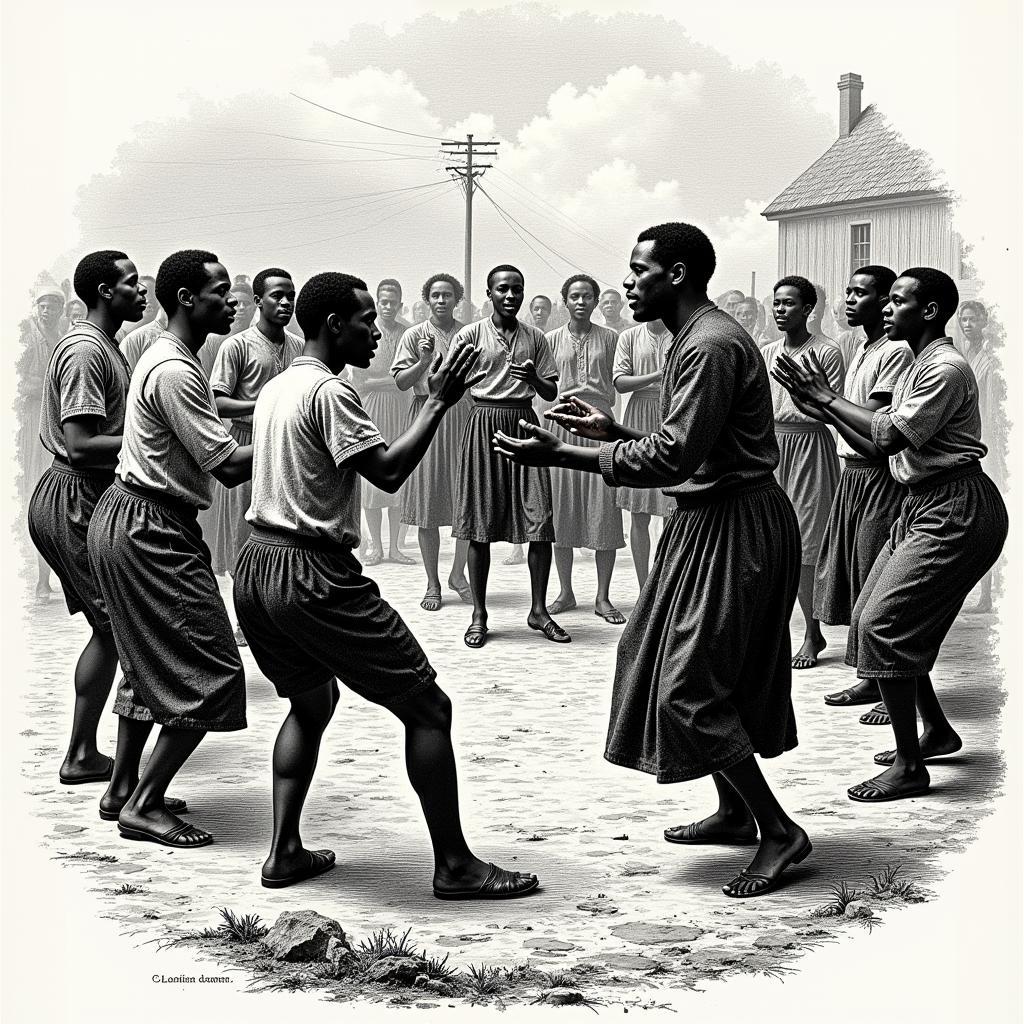A Rhythmic Journey: Exploring African American Dance History
African American Dance History is a vibrant tapestry woven from the threads of resilience, creativity, and cultural expression. From the forced migrations of the transatlantic slave trade to the contemporary stages of today, dance has served as a powerful tool for communication, preservation, and resistance within the African American community. This journey through time reveals the evolution of unique dance forms, reflecting both the struggles and triumphs of a people.  African American Ring Shout Dance: A depiction of the ring shout, a traditional African American dance form, showing participants moving in a circular formation with rhythmic clapping and singing.
African American Ring Shout Dance: A depiction of the ring shout, a traditional African American dance form, showing participants moving in a circular formation with rhythmic clapping and singing.
From African Roots to American Soil: The Early Influences
The story of African American dance begins in Africa. Traditional dances, rich with symbolism and deeply connected to spirituality and daily life, were brought to America through the Middle Passage. Though suppressed by enslavers, these movements found new life in hidden gatherings, evolving into forms like the ring shout, a circular dance accompanied by rhythmic clapping and singing. This powerful expression of faith and resilience became a cornerstone of African American cultural identity.
What were the earliest forms of African American dance? The earliest forms often incorporated elements of West African traditions, adapted and transformed within the context of slavery. These dances served as a vital link to ancestral heritage and a means of expressing hope and community.
The Rise of Minstrelsy and its Complex Legacy
The 19th century saw the rise of minstrelsy, a form of entertainment that often featured white performers in blackface, portraying distorted and stereotypical representations of African American life, including dance. While undeniably offensive, minstrelsy inadvertently provided a platform for some black performers, who eventually began to reclaim and reshape these representations. This era, though fraught with racism, laid the groundwork for the emergence of black performance traditions in the mainstream.
How did African American dance evolve during the minstrelsy era? Black performers, despite the limitations and prejudices of the time, began to use the minstrel stage to inject their own artistry and interpretations into the performances, subtly challenging the prevailing stereotypes.
The Jazz Age and the Birth of New Rhythms
The early 20th century brought the explosion of jazz music, and with it, a revolution in dance. African American dancers embraced the syncopated rhythms and improvisational spirit of jazz, creating dynamic new forms like the Charleston, the Lindy Hop, and the Black Bottom. These dances, full of energy and innovation, became synonymous with the era, reflecting the changing social and cultural landscape. These dances transcended racial boundaries, captivating audiences worldwide and solidifying the influence of African American dance on popular culture. See our african american dance history timeline for more detailed information.
What was the impact of jazz music on African American dance? Jazz music infused African American dance with a new sense of dynamism and improvisation, leading to the creation of iconic dances that defined the Jazz Age.
The Modern Era: A Continuum of Innovation
From the mid-20th century to the present day, African American dancers have continued to push boundaries and redefine the art form. Pioneers like Katherine Dunham and Alvin Ailey drew inspiration from African roots and blended them with modern dance techniques, creating powerful and expressive new styles. african american belly dancer have also emerged, showcasing a captivating fusion of cultural influences. Today, African American choreographers and dancers continue to shape the landscape of contemporary dance, drawing on a rich heritage while forging new paths of artistic expression. You can also learn about african american line dances. More information on the meaning of the term can be found at african american meaning.
What are some key figures in modern African American dance? Katherine Dunham, Alvin Ailey, and a host of other influential choreographers and dancers have shaped the landscape of modern and contemporary dance, building on the traditions of the past while forging new artistic directions.
Conclusion: Celebrating the Legacy and Future of African American Dance
African American dance history is a testament to the enduring power of creativity and cultural resilience. From the earliest forms brought from Africa to the innovative styles of today, dance has played a pivotal role in shaping the identity and expression of the African American community. As we celebrate this rich legacy, we look forward to the continued evolution and impact of African American dance on the global stage. Don’t forget to explore different african american dreadlocks styles which often complement the dance forms.
FAQ
-
What is the ring shout? The ring shout is a traditional African American dance form involving a circular movement accompanied by rhythmic clapping and singing.
-
How did minstrelsy impact African American dance? While racist in nature, minstrelsy provided a platform, albeit a flawed one, for black performers to eventually reclaim and reshape representations of their culture.
-
What are some key dances of the Jazz Age? The Charleston, the Lindy Hop, and the Black Bottom are some of the iconic dances that emerged during the Jazz Age.
-
Who are some influential figures in modern African American dance? Katherine Dunham and Alvin Ailey are two pioneering figures who shaped modern African American dance.
-
What is the significance of African American dance history? It reflects the resilience, creativity, and cultural expression of the African American community throughout history.
Need Help?
Contact us 24/7 for support.
Phone: +255768904061
Email: [email protected]
Address: Mbarali DC Mawindi, Kangaga, Tanzania.

